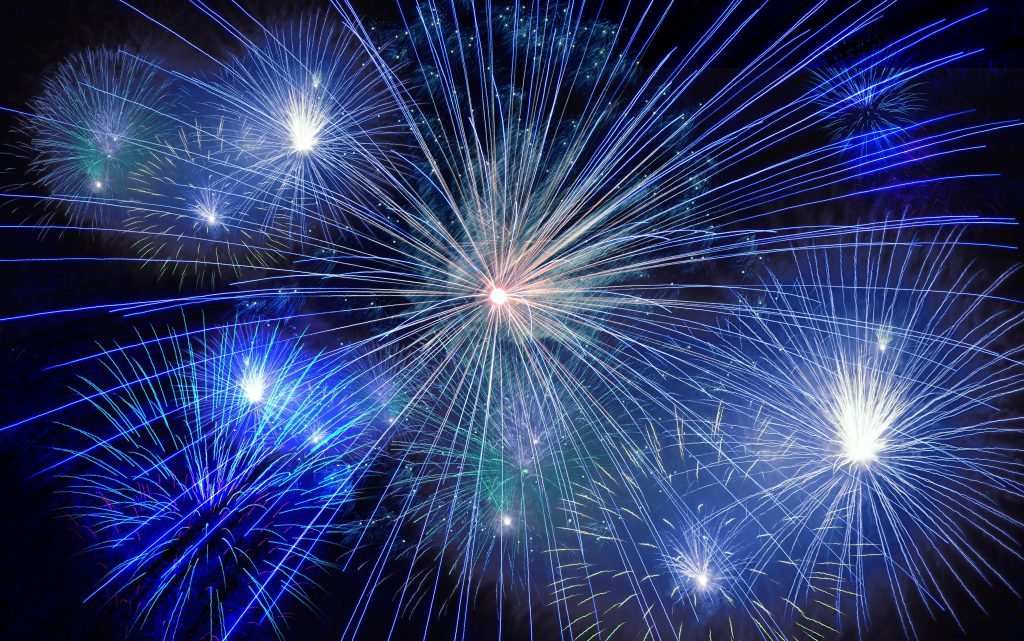
Many dogs are frightened of fireworks, and whilst this can be unavoidable, there are some steps you can take to prevent stress and fear if your dog has not experienced them before, or to try to minimise it, if you have a dog that is already fearful.
In this article we look at all scenarios, but it must be stressed that ideally it is always advisable to ask an Animal Behaviour and Training Council (ABTC) accredited trainer, clinical animal behaviourist, or veterinary behaviourist, to help you help your dog according to her/his temperament and specific needs. Their knowledge and expertise will help you to avoid mistakes.
How to respond to a dog that has already developed fear of fireworks:
- Check that your front door and any garden gates, are locked. If anyone in your household is not at home during fireworks, ask them to ring the bell or call you when they return. They will have to wait for you to tell them when they can enter. This will help to avoid possible accidents involving a dog escaping from home as it will give you time to keep your dog away from the door.
- Provide more than one place, in different rooms, where your dog can hide during fireworks if they want to. These places can be crates and/or cosy dens that should ideally have clothes/blankets over them so that they can give your dog a feeling of extra protection.
- Close any windows and draw curtains (that should ideally be thick) as the first will decrease the fireworks sound and the second will block out the flashes and lights.
- Use your tv/pc/mobile to play a movie, video clips, music, etc. If the speaker volume is high this will help to cover, at least to a certain extent, the sound of the fireworks.
- Leave in the rooms a variety of toys (e.g. kongs, balls, chew toys) and chew bones. Some dogs, as part of their coping behaviour reaction, may focus their attention and chew/play with them in an attempt to get relief from stress.
- Attempt to see if your dog is willing to engage with a favourite indoors exercise activity such as fetch a ball, search for a treat/toy, food puzzles, etc.
- Pheromones released from a neck collar or a plug-in device can help your dog to relax and make your dog feel better before, during and after the fireworks.
- Ensure you let your dog out to go to the toilet early in the evening before the fireworks start, and keep them inside until they have stopped.
Five things to avoid when the fireworks start:
- Don’t force your dog to remain in the garden/yard and/or in a room that they want to leave.
- Don’t try to make them stay on command.
- Don’t tie them up with a lead at a firm point.
- Don’t ignore them if they are feeling afraid and are seeking company, physical contact, encouraging/reassuring words and petting/cuddles from you.
- Don’t take them out for a walk.
Preparing a puppy, or young dog, for fireworks
If you have a puppy or dog that has never heard or seen fireworks before, there are some additional steps you can take to prepare them for this time:
- For many dogs, it is the sound of fireworks which can be the most distressing part of the fireworks, so some time spent acclimatising your dog to the sound can be very beneficial. You can buy CDs of firework sounds or search online for firework sounds. You can then play these sounds at a very, very low level, gradually increasing the volume over time, whilst gauging your dog’s reaction and decreasing the volume/slowing down the progression of volume increase accordingly. However, this process must be undertaken very carefully – if done incorrectly or too quickly, it could increase stress or even cause fear.
- If you are able to, you can close all curtains to block out the flash of lights, but if this is not possible there are ways to accustom your dog to flashes. Use your mobile/camera flash and shoot photos at a 5-6 meters distance from your dog (without pointing it towards them). Gradually, as time goes and according to your dog’s reaction and progress you can decrease the distance and point more towards the dog. The sessions should take place initially during the daylight and as time goes on you can do them in the dark. In case your home layout gives you the option, shoot photos with flash from the outside close to the ground floor windows after dark so your dog can see the flashes from the inside. This training task will help your dog to get habituated to the flash element of the fireworks.
- Combine the two previously described training tasks into one. Among other training scenarios, and in an attempt to be as realistic as possible you can play fireworks videos on your tv. If at any step described above you see that your dog is anxious or stressed, stop the session immediately and repeat the previous training steps. If you see that the problem persists, stop the whole procedure and ask for professional help.
IMPORTANT: Please bear in mind that not all the information mentioned above will prevent every dog becoming afraid, anxious or stressed during fireworks. Therefore, it is highly recommended to ask for professional help and guidance as appropriate
